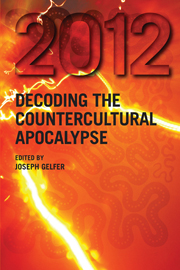Book contents
- Frontmatter
- Contents
- Contributors
- Preface
- 1 Introduction
- 2 The 2012 Phenomenon: New Uses for an Ancient Maya Calendar
- 3 Maya Prophecies, 2012 and the Problematic Nature of Truth
- 4 Mayanism Comes of (New) Age
- 5 The 2012 Milieu? Hybridity, Diversity and Stigmatised Knowledge
- 6 Chichén Itzá and Chicken Little: How Pseudosciences Embraced 2012
- 7 Roland Emmerich's 2012: A Simple Truth
- 8 The 2012 Movement, Visionary Arts and Psytrance Culture
- 9 In a Prophetic Voice: Australasia 2012
- 10 Approaching 2012: Modern Misconceptions versus Reconstructing Ancient Maya Perspectives
- Notes
- Index
3 - Maya Prophecies, 2012 and the Problematic Nature of Truth
- Frontmatter
- Contents
- Contributors
- Preface
- 1 Introduction
- 2 The 2012 Phenomenon: New Uses for an Ancient Maya Calendar
- 3 Maya Prophecies, 2012 and the Problematic Nature of Truth
- 4 Mayanism Comes of (New) Age
- 5 The 2012 Milieu? Hybridity, Diversity and Stigmatised Knowledge
- 6 Chichén Itzá and Chicken Little: How Pseudosciences Embraced 2012
- 7 Roland Emmerich's 2012: A Simple Truth
- 8 The 2012 Movement, Visionary Arts and Psytrance Culture
- 9 In a Prophetic Voice: Australasia 2012
- 10 Approaching 2012: Modern Misconceptions versus Reconstructing Ancient Maya Perspectives
- Notes
- Index
Summary
Repent! The end is nigh. Again.
The latest excuse for us to contemplate reforming-our-wicked-ways-before-it-is-too-late has been co-opted from ancient Maya calendar arithmetic, heavily larded with New Age astrology, a dash of hallucinogens, and the usual dollops of wishful thinking. On the morning of the winter solstice, 21 December 2012, the ancient Maya calendar cycle will “end.” It has a nice symmetry even in its modern abbreviated form: 12/21/12. Like the Beijing Olympics' triply-lucky starting date 08/08/08, this numerological coincidence is seen as significant in itself.
Some latter-day prophets foresee literal destruction, but most couch their expectations in terms of “cosmic transformation” or “profound shift of perspective.” Few of them have any knowledge of the Maya themselves, nor of what they might have prophesied, or believed, or known, nor even the tiny fraction that we know, of their knowledge. Comparing what these modern writers project upon the ancient Maya to what the Maya actually did and said is like comparing Hercules to Pericles. It is like proposing the story of Snow White as an accurate record of daily life in Medieval Europe.
In fact, so far as we know, the Maya never mention destruction, nor even a change, on that fateful day. The Maya Long Count Calendar, which began its latest “Great Cycle” in August of 3114 BCE, called that day 13.0.0.0.0 (with a Calendar Round date 4 Ajaw 8 Kumk'u).
- Type
- Chapter
- Information
- 2012Decoding the Countercultural Apocalypse, pp. 23 - 37Publisher: Acumen PublishingPrint publication year: 2012



